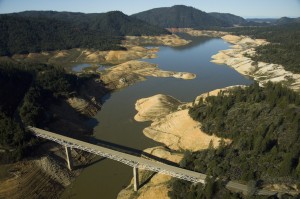The Department of Water Resources announced today that it’s initial allocation for State Water Project deliveries for the upcoming year is just 5%, or just 208,628 acre-feet of the 4,172,536 acre-feet if water that is contracted for by state water contractors. It is one of the lowest initial allocations ever issued, but officials said that the allocation could increase with additional storms.
“We hope things improve with this winter’s storms,but there is no guarantee that 2014 won’t be our third consecutive dry year,” cautioned DWR Director Mark Cowin in a news release. “Today’s allocation is a stark reminder that California’s fickle weather demands that we make year-round conservation a way of life.”
The initial allocation is largely dictated by storage levels in the state’s reservoirs and is conservative because it is made before the wettest period of the year. The allocation will be updated as the winter season progresses based on snowpack accumulation. On average, half of the state’s precipitation occurs from December through February. The previous lowest initial SWP allocation was issued in 2010, and was eventually increased to 50%.
Water contractors took the opportunity to push for the Bay Delta Conservation Plan, citing the 700,000 acre-feet that was lost earlier this year due to restrictions put on the pumps to protect endangered fish. “We lost an opportunity earlier this year to capture a significant amount of water due to our outdated water system,” said Terry Erlewine, General Manager of the State Water Contractors. “If we had a more modern water delivery system in place, like that proposed under the Bay Delta Conservation Plan, we would have more water in storage and today’s low allocation announcement wouldn’t be so dire.”
“A low allocation is not just a reflection of the weather—our antiquated water system also limits how much water is available for the 25 million people, businesses and farms that rely on water from the Sierra Nevada Mountains,” said Richard Atwater, Southern California Water Committee. “We need a modern water system that allows us to take advantage of wet periods so we can store enough water to protect us during droughts and long dry spells. The Bay Delta Conservation Plan seeks to use today’s technology to ensure that we can access Sierra Nevada water, while protecting the environment.”
Central Valley legislators decried the announcement. “While this is an unusually dry year, it is unacceptable that our residents, farmers, and small businesses pay 100 percent but only receive 5 percent of the water they contract and pay for. I call on federal and state officials to take immediate action to increase needed water supplies to the 25 million residents and for the more than 750,000 acres of agricultural land throughout California,” said Republican Congressman Kevin McCarthy.
“Communities and cities in the Valley continue to be deprived of their fundamental right to water because of extreme environmentalists that promote policies that place the needs of animals and fish above those of families, farmers and agricultural workers,” said State Senator Andy Vidak.
Storage in Lake Oroville, the State Water Project’s principal reservoir, is only at 41% of capacity.
If 2014 turns out to be a third consecutive dry year, the greatest risks will be from increased wildfire risks that can impact public health and safety, officials say. Additionally, small rural water systems that rely on fractured rock groundwater can experience shortages. Minimal surface water allocations to farmers can result in economic impacts to the Central Valley, as well as increased groundwater pumping, which can lead to increased subsidence issues.
To read the Department of Water Resources press release, click here.
For the latest reservoir conditions, click here.
Written by: Chris “Maven” Austin

You must be logged in to post a comment.